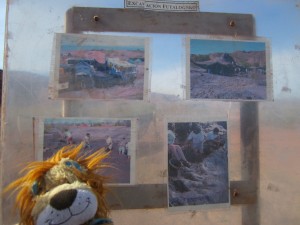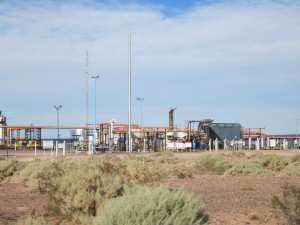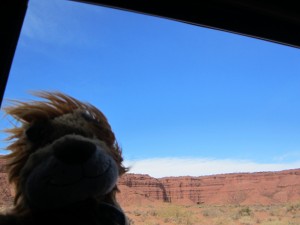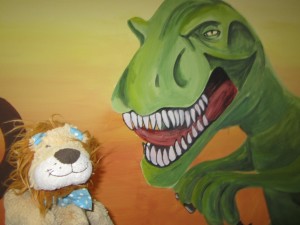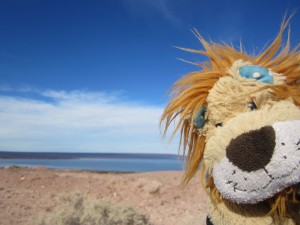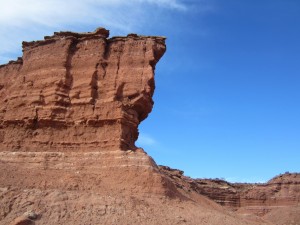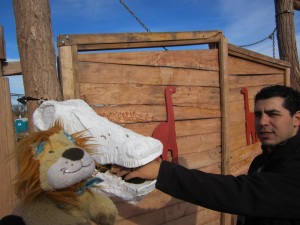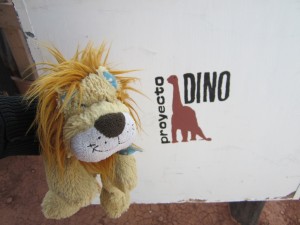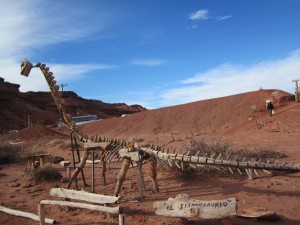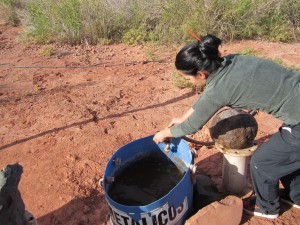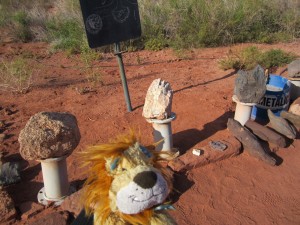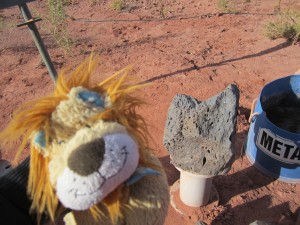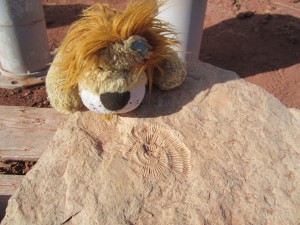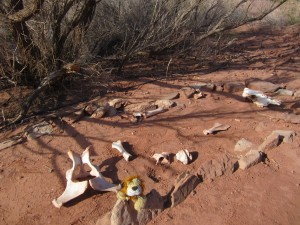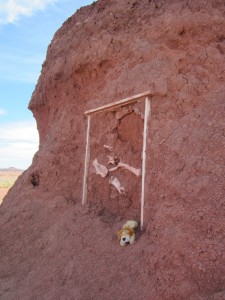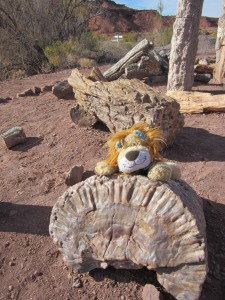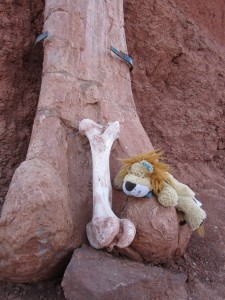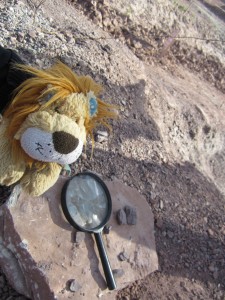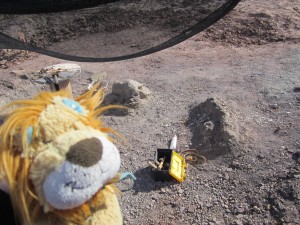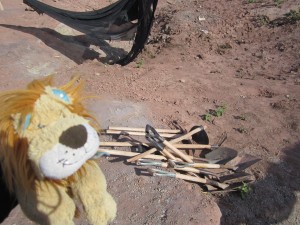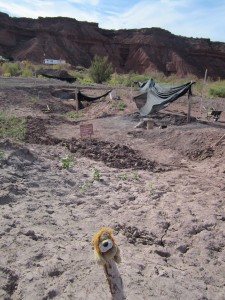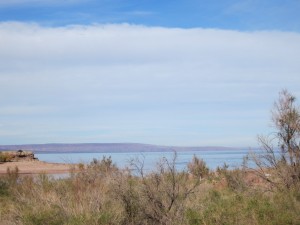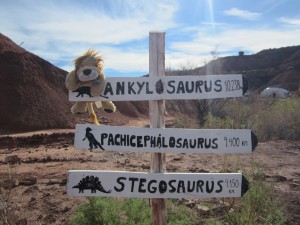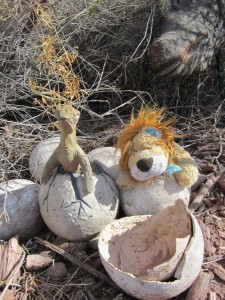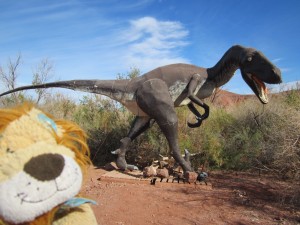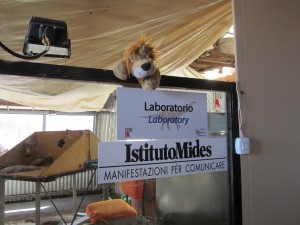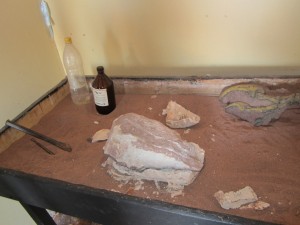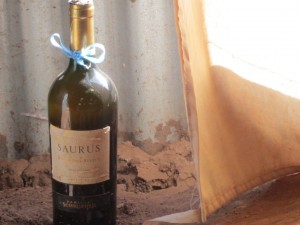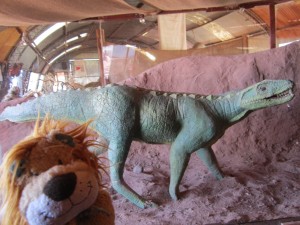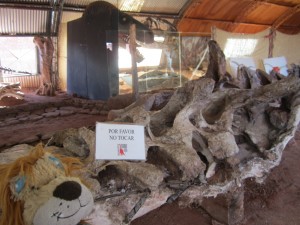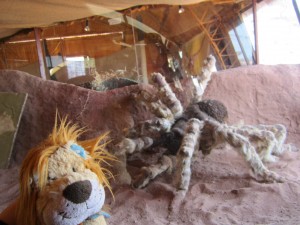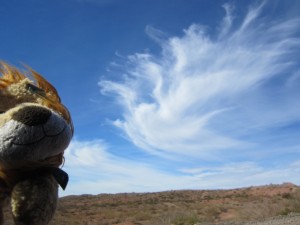Thanks to the inspiration of Lewis the Lion’s friend, Dominic on this website (see Dominic’s comment), he decided to go on the hunt for dinosaur fossils in Neuquén, Argentina.
To find out more about this paleontological centre, click on this link.
This particular site with dinosaur bones was especially impressive because in the year 2000 they started to unearth one of the biggest intact dinosaur fossils ever found.
It was of a herbivorous dinosaur, the futalognkosaurus – “the giant chief of lizards,” which had roamed the earth more than 80 million years ago. It would have been more than 32 metres long!
Patagonia in Argentina is a unique location for the discovery of fossils for a number of reasons. Firstly, because it used to be covered by the ocean and is mainly made up sedimentary rock: in other words it is very fossil rich and in fact Argentina has some of the world’s largest reserves of shale oil and gas. Lewis the Lion saw some of these on his journey to Lake Barreales.
Secondly, it also falls in the middle of one complete, tectonic plate so the earth is generally static. In other words, it is not near earthquake or volcanic zones where there is greater earth movement. That means that generally fossils tend to remain more intact as the earth remains more undisturbed.
Thirdly, millions of years ago, the area of Lake Barreales in the region of Neuquén, was in a dense rainforest in a warm and humid climate. This means that the soils are very mineral rich; again ideal for the preservation of dinosaur bones as they absorb the minerals in the soil to fossilise them. Lewis the Lion thought this was a wonderful place to visit as he was sure to learn lots of new facts and Lewis simply loves learning new things!
However, this place wasn’t so easy to visit as there is not a lot of tourist infrastructure but luckily for Lewis the Lion the hostel where he was staying, el hostel Portal de Sueños, had great staff who were very welcoming and who even drove him to the dinosaur site themselves!
He even had a Spanish and English bi-lingual guide, Rocio, all to himself, to help him understand more about the visit to the paleontological site.
The drive to the site which was about 90km away, took Lewis the Lion initially through a productive agricultural zone but this wasn’t always the case. Thanks to the British who had arrived several centuries beforehand, they had turned a desert area into farmlands by irrigating the land, building dams and planting apple and pear trees. Today the province of Neuquén is one of Argentina’s wealthiest, both for its fossil fuels and wines.
Heading further towards Lake Barreales, the scenery changed to flat planes, scrubland and the colour of the layered, sedimentary rocks grew more and more orange.
In fact the smooth tarmac road disappeared from under the wheels of the car and they were on a dirt track, bumping and juddering along, all whilst hearing the odd stone or pebble hitting off the sides of the car. Lewis the Lion felt like he was in a real adventure movie!
However, it was just about to get better, as they arrived outside the paleontological site. Lewis the Lion had to put his paw in the mouth of a dinosaur in order to ring the bell to get in: what a novelty!
Lewis the Lion and Helen felt exceptionally privileged as they were the only visitors to the site this particular bright and sunny morning so they had the sole attention of the palaeontologist who showed them around the site. How lucky!
Under the bright blue sky, set against the orange of the desert rocks, Lewis the Lion only had one disappointment in his head: he wished that he could have all the children with him that he had met on his travels as he knew that they would love this visit too. So, he made a mental note to remember as many cool dinosaur facts as possible so that he could write them here on his blog and share them with you instead.
So, this is what he remembers from his special time with the palaeontologist.
First of all, she explained about the three different rock groups as this was important if you wanted to discover dinosaur bones! The three rock groups are as follows:
– Igneous rocks: formed in the magma of the volcano. As there is so much oxygen when the volcano erupts, they are often filled with little air bubbles so they float in water, e.g. granite, quartz and pumice.
The palaeontologist did a cool experiment to show Lewis the Lion that even an enormous pumice stone floated in a bucket of water!
– Metamorphic rocks: formed when igneous and sedimentary rocks are changed under pressure, e.g. marble and gneiss. These rocks are heavy and dense.
– Sedimentary rocks: formed over millions of years when grains of eroded earth sink and form layers. The pressure then turns them into rocks, e.g. sandstone, limestone and shale. The palaeontologist showed Lewis the Lion some ammonites that had been found in the sedimentary rock nearby. These have a ribbed, spiral form and look like snail imprints in the rock. These are perhaps the most well-known types of fossils.
You can click here to take you to a website called Rock Hounds for some more information.
After discovering about the rocks, Lewis understood why Neuquén was such a great place to find fossils because it was made up of mainly sedimentary rock!
Lewis the Lion wasn’t quite sure what a fossil was exactly so the scientist explained that a fossil is the remains or the impression of a prehistoric organism which is found preserved in the rock. The palaeontologist then went on to explain to Lewis the Lion how fossils are formed in the first place.
Firstly, when a creature or organism dies it starts to decompose. It then loses minerals and calcium which get dispersed into the soil. However, when the soil is mineral rich already, as it is in Neuquén as it used to be a rainforest millions of years ago, the soil starts to exchange minerals with the organism, thus strengthening it or fossilising it.
The palaeontologist showed Lewis the Lion some very interesting fossilised plants where the roots appeared blue due to the mineral copper which had been in the soil.
Lewis the Lion then saw the most extraordinary fossil he had ever seen in his little life! It was the femur (the thigh bone) of the futalognkosaurus – one of the dinosaur bones of this mighty dinosaur that used to roam the land of Neuquén. It was so big that it was even taller than his friend, Helen, as you can see in this picture!
Beside it, just to show the comparison, is the femur of a modern day cow. Can you imagine how big the real dinosaur must have been?!
Lewis the Lion was now curious to know how the palaeontologists carry out this work of careful excavation in the first place? Obviously, it is very delicate and painstaking work to make sure that the fossils are removed carefully from the ground.
He saw that they use a wide range of tools to carry out their work: magnifying glasses, spades and brushes.
In the permanent excavation site where they had discovered the enormous dinosaur fossils, there were also huge nets to protect the palaeontologists from the sun as in the summer it gets very hot; sometimes up to 50 degrees centigrade or more!
It was just as well that there was the cool lake nearby where they could swim to cool off!
The palaeontologist also explained how the fossils are then transported from the site. They need to be carefully preserved and so a cast is made out of plaster, folding metal, tissue paper and cloth.
Around the rest of the work site, there were big signs pointing to the direction of where other dinosaur bones had been discovered around the world and Lewis the Lion wondered he might end up in some of those places too on his travels?
As he pondered this thought, there was a bird singing an unusual song very loudly as you can see on this video clip. Lewis the Lion wondered if the bird was curious too, as there seemed to be a huge nest full of eggs under the tree…
Thankfully, they were just replica dinosaur eggs of a herbivorous (a plant eating) dinosaur.
Lewis the Lion then saw the difference in the size of the footprints of a herbivorous dinosaur and a carnivorous (meat eating) dinosaur. He learned that herbivorous dinosaurs had wide, large feet, whilst carnivorous dinosaurs had smaller feet with claws.
Why do you think that is?
To finish off the tour of this unique site, Lewis visited a museum linked to it and saw the laboratories where the scientists work.
Here he saw many interesting objects and learnt some more fascinating facts about dinosaurs:
-Some of the sponsors for the paleontological site are an American company called Schroeder. There was a vineyard where some dinosaur fossils were discovered and so they named their wine “Saurus!”
-Once upon a time, crocodiles had legs!
-Here he saw the spine of the futalognkosaurus along with the hip bone which had been flattened by the pressure of the earth.
-Lewis the Lion also pretended to be gobbled up by a carnivorous dinosaur – the megaraptor – dinosaur fossils of which have also been found in Patagonia.
Luckily for Lewis the Lion, this was just a replica and furthermore, Lewis was glad to remind himself that dinosaurs are extinct today, especially when he saw the exoskeleton of a gigantic spider from the time of the dinosaurs!
What an amazing fact-filled morning for Lewis the Lion, all in such dramatic scenery that seemed to transport him back in time to a prehistoric world.
If you had the chance to excavate some dinosaur fossils, which dinosaur fossils would you like to find and why?
Do you know where you would find them?


